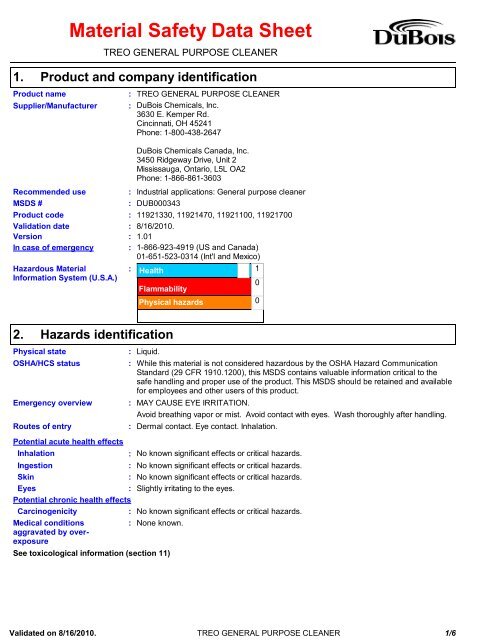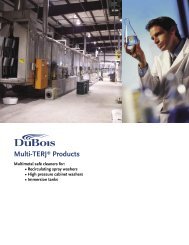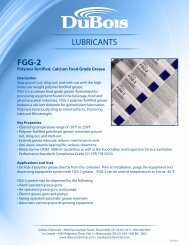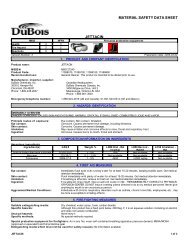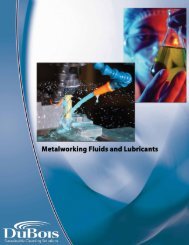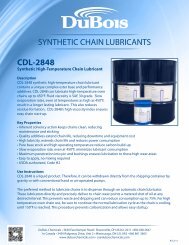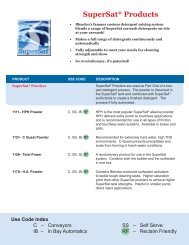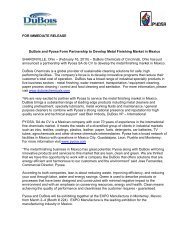MSDS - DuBois Chemicals Online Store
MSDS - DuBois Chemicals Online Store
MSDS - DuBois Chemicals Online Store
You also want an ePaper? Increase the reach of your titles
YUMPU automatically turns print PDFs into web optimized ePapers that Google loves.
1.Product nameSupplier/ManufacturerRecommended use<strong>MSDS</strong> #Material Safety Data SheetTREO GENERAL PURPOSE CLEANERProduct and company identification: TREO GENERAL PURPOSE CLEANER: <strong>DuBois</strong> <strong>Chemicals</strong>, Inc.3630 E. Kemper Rd.Cincinnati, OH 45241Phone: 1-800-438-2647::<strong>DuBois</strong> <strong>Chemicals</strong> Canada, Inc.3450 Ridgeway Drive, Unit 2Mississauga, Ontario, L5L OA2Phone: 1-866-861-3603Industrial applications: General purpose cleanerDUB000343Product code : 11921330, 11921470, 11921100, 11921700Validation date: 8/16/2010.Version : 1.01In case of emergency : 1-866-923-4919 (US and Canada)01-651-523-0314 (Int'l and Mexico)Hazardous MaterialInformation System (U.S.A.):HealthFlammabilityPhysical hazards1002.Physical stateHazards identificationOSHA/HCS statusEmergency overviewRoutes of entryPotential acute health effectsInhalationIngestionSkinEyesMedical conditionsaggravated by overexposureLiquid.See toxicological information (section 11):: While this material is not considered hazardous by the OSHA Hazard CommunicationStandard (29 CFR 1910.1200), this <strong>MSDS</strong> contains valuable information critical to thesafe handling and proper use of the product. This <strong>MSDS</strong> should be retained and availablefor employees and other users of this product.:::MAY CAUSE EYE IRRITATION.Avoid breathing vapor or mist. Avoid contact with eyes. Wash thoroughly after handling.No known significant effects or critical hazards.: No known significant effects or critical hazards.: No known significant effects or critical hazards.: Slightly irritating to the eyes.:Dermal contact. Eye contact. Inhalation.Potential chronic health effectsCarcinogenicity: No known significant effects or critical hazards.None known.Validated on 8/16/2010.TREO GENERAL PURPOSE CLEANER1/6
3.Composition/information on ingredientsName CAS number %SODIUM CARBONATE 497-19-8 1 - 5There are no additional ingredients present which, within the current knowledge of the supplier and in theconcentrations applicable, are classified as hazardous to health or the environment and hence require reporting inthis section.4.First aid measuresEye contactSkin contactInhalationIngestionProtection of first-aidersNotes to physician5.Fire-fighting measuresFlammability of the product :Extinguishing mediaSuitable :Not suitable :Special exposure hazards :Hazardous thermaldecomposition productsSpecial protectiveequipment for fire-fighters:::::Check for and remove any contact lenses. Immediately flush eyes with plenty of water forat least 15 minutes, occasionally lifting the upper and lower eyelids. Get medical attentionimmediately.In case of contact, immediately flush skin with plenty of water for at least 15 minutes whileremoving contaminated clothing and shoes. Wash clothing before reuse. Clean shoesthoroughly before reuse. Get medical attention immediately.Move exposed person to fresh air. If not breathing, if breathing is irregular or if respiratoryarrest occurs, provide artificial respiration or oxygen by trained personnel. Loosen tightclothing such as a collar, tie, belt or waistband. Get medical attention immediately.Wash out mouth with water. Do not induce vomiting unless directed to do so by medicalpersonnel. Never give anything by mouth to an unconscious person. Get medicalattention immediately.: No action shall be taken involving any personal risk or without suitable training. It may bedangerous to the person providing aid to give mouth-to-mouth resuscitation.:No specific treatment. Treat symptomatically. Contact poison treatment specialistimmediately if large quantities have been ingested or inhaled.In a fire or if heated, a pressure increase will occur and the container may burst.Use an extinguishing agent suitable for the surrounding fire.None known.Promptly isolate the scene by removing all persons from the vicinity of the incident if thereis a fire. No action shall be taken involving any personal risk or without suitable training.: Decomposition products may include the following materials:carbon dioxidecarbon monoxidemetal oxide/oxidesFire-fighters should wear appropriate protective equipment and self-contained breathingapparatus (SCBA) with a full face-piece operated in positive pressure mode.6.Accidental release measuresPersonal precautions :Environmental precautionsMethods for cleaning upNo action shall be taken involving any personal risk or without suitable training. Evacuatesurrounding areas. Keep unnecessary and unprotected personnel from entering. Do nottouch or walk through spilled material. Avoid breathing vapor or mist. Provide adequateventilation. Wear appropriate respirator when ventilation is inadequate. Put onappropriate personal protective equipment (see section 8).: Avoid dispersal of spilled material and runoff and contact with soil, waterways, drains andsewers. Inform the relevant authorities if the product has caused environmental pollution(sewers, waterways, soil or air).Small spill :Stop leak if without risk. Move containers from spill area. Dilute with water and mop up ifwater-soluble. Alternatively, or if water-insoluble, absorb with an inert dry material andplace in an appropriate waste disposal container. Dispose of via a licensed wastedisposal contractor.Validated on 8/16/2010.TREO GENERAL PURPOSE CLEANER2/6
6.Accidental release measuresLarge spill :7.HandlingStorage8.Handling and storageOccupational exposure limitsNo exposure limit value known.::Stop leak if without risk. Move containers from spill area. Approach release from upwind.Prevent entry into sewers, water courses, basements or confined areas. Wash spillagesinto an effluent treatment plant or proceed as follows. Contain and collect spillage withnon-combustible, absorbent material e.g. sand, earth, vermiculite or diatomaceous earthand place in container for disposal according to local regulations (see section 13).Dispose of via a licensed waste disposal contractor. Contaminated absorbent materialmay pose the same hazard as the spilled product. Note: see section 1 for emergencycontact information and section 13 for waste disposal.Put on appropriate personal protective equipment (see section 8). Eating, drinking andsmoking should be prohibited in areas where this material is handled, stored andprocessed. Workers should wash hands and face before eating, drinking and smoking.Do not ingest. Avoid contact with eyes, skin and clothing. Avoid breathing vapor or mist.Keep in the original container or an approved alternative made from a compatiblematerial, kept tightly closed when not in use. Empty containers retain product residue andcan be hazardous. Do not reuse container.<strong>Store</strong> in accordance with local regulations. <strong>Store</strong> in original container protected fromdirect sunlight in a dry, cool and well-ventilated area, away from incompatible materials(see section 10) and food and drink. Keep container tightly closed and sealed until readyfor use. Containers that have been opened must be carefully resealed and kept uprightto prevent leakage. Do not store in unlabeled containers. Use appropriate containmentto avoid environmental contamination.Exposure controls/personal protectionConsult local authorities for acceptable exposure limits.Recommended monitoringproceduresEngineering measuresHygiene measuresPersonal protectionRespiratoryHands :EyesSkin: If this product contains ingredients with exposure limits, personal, workplace atmosphereor biological monitoring may be required to determine the effectiveness of the ventilationor other control measures and/or the necessity to use respiratory protective equipment.: No special ventilation requirements. Good general ventilation should be sufficient tocontrol worker exposure to airborne contaminants. If this product contains ingredientswith exposure limits, use process enclosures, local exhaust ventilation or otherengineering controls to keep worker exposure below any recommended or statutorylimits.: Wash hands, forearms and face thoroughly after handling chemical products, beforeeating, smoking and using the lavatory and at the end of the working period. Appropriatetechniques should be used to remove potentially contaminated clothing. Washcontaminated clothing before reusing. Ensure that eyewash stations and safety showersare close to the workstation location.:::Use a properly fitted, air-purifying or air-fed respirator complying with an approvedstandard if a risk assessment indicates this is necessary. Respirator selection must bebased on known or anticipated exposure levels, the hazards of the product and the safeworking limits of the selected respirator.Chemical-resistant, impervious gloves complying with an approved standard should beworn at all times when handling chemical products if a risk assessment indicates this isnecessary.Recommended: natural rubber (latex)Safety eyewear complying with an approved standard should be used when a riskassessment indicates this is necessary to avoid exposure to liquid splashes, mists ordusts. Recommended: splash gogglesPersonal protective equipment for the body should be selected based on the task beingperformed and the risks involved and should be approved by a specialist before handlingthis product.Validated on 8/16/2010.TREO GENERAL PURPOSE CLEANER3/6
8.Exposure controls/personal protectionEnvironmental exposurecontrolsPersonal protectiveequipment (Pictograms): Emissions from ventilation or work process equipment should be checked to ensure theycomply with the requirements of environmental protection legislation. In some cases,fume scrubbers, filters or engineering modifications to the process equipment will benecessary to reduce emissions to acceptable levels.:9.Physical stateFlash pointColorOdorpHPhysical and chemical propertiesLiquid.Green.surfactant [Slight]11.2Dilution pH : 10.3 [Conc. (% w/w): 1%]Boiling/condensation point : Not available.Melting/freezing pointSpecific gravityDensityVapor pressureVapor densityOdor thresholdEvaporation rateSolubility:: Closed cup: Not applicable.::::Not available.: 1.045: 8.720525 lbs/gal: Not available.: Not available.: Not available.::Not available.Elemental Phosphorus : 0 %Octanol/water partition : Not available.coefficient10.Stability and reactivityChemical stabilityConditions to avoidMaterials to avoidHazardous decompositionproductsPossibility of hazardousreactions11.::::Easily soluble in the following materials: cold water and hot water.The product is stable.No specific data.Toxicological informationAcute toxicityReactive or incompatible with the following materials:acidsUnder normal conditions of storage and use, hazardous decomposition products shouldnot be produced.: Under normal conditions of storage and use, hazardous reactions will not occur.Product/ingredient name Result Species Dose ExposureSODIUM CARBONATE LD50 Oral Rat 4090 mg/kg -Conclusion/SummaryTREO GENERALPURPOSE CLEANERCarcinogenicityNone known.:Oral LD50 estimated to be 4000 - 5000 mg/kg. Dermal LD50 estimated to be > 2000mg/kg.Validated on 8/16/2010.TREO GENERAL PURPOSE CLEANER4/6
12.EcotoxicityEcological informationAquatic ecotoxicityNone known.13.Disposal considerationsWaste disposal: No known significant effects or critical hazards.:The generation of waste should be avoided or minimized wherever possible. Emptycontainers or liners may retain some product residues. This material and its containermust be disposed of in a safe way. Dispose of surplus and non-recyclable products via alicensed waste disposal contractor. Disposal of this product, solutions and any byproductsshould at all times comply with the requirements of environmental protectionand waste disposal legislation and any regional local authority requirements. Avoiddispersal of spilled material and runoff and contact with soil, waterways, drains andsewers.Disposal should be in accordance with applicable regional, national and local laws and regulations.Refer to Section 7: HANDLING AND STORAGE and Section 8: EXPOSURE CONTROLS/PERSONAL PROTECTION foradditional handling information and protection of employees.14.Transport informationDOT/TDG: Please refer to the Bill of Lading/receiving documents for up to date shipping information.15.United StatesRegulatory informationU.S. Federal regulationsUnited States inventory(TSCA 8b)SARA 313None identified.State regulationsMassachusetts: None of the components are listed.Rhode Island: None of the components are listed.New Jersey: None of the components are listed.Pennsylvania: None of the components are listed.California Prop. 65None of the components are listed.CanadaWHMIS (Canada): Not controlled under WHMIS (Canada).Canadian listsCanadian NPRI : None of the components are listed.Canada inventory: All components are listed or exempted.This product has been classified in accordance with the hazard criteria of the Controlled Products Regulations andthe <strong>MSDS</strong> contains all the information required by the Controlled Products Regulations.International regulationsInternational listsEurope inventoryValidated on 8/16/2010.: TSCA 12(b) one-time export: No products were found.TSCA 12(b) annual export notification: No products were found.: All components are listed or exempted.SARA 311/312 <strong>MSDS</strong> distribution - chemical inventory - hazard identification: TREOGENERAL PURPOSE CLEANERSARA 302/304/311/312 extremely hazardous substances: No products were found.CERCLA: Hazardous substances.: No products were found.: Australia inventory (AICS): All components are listed or exempted.China inventory (IECSC): Not determined.Japan inventory: Not determined.Korea inventory: All components are listed or exempted.New Zealand Inventory of <strong>Chemicals</strong> (NZIoC): All components are listed or exempted.Philippines inventory (PICCS): All components are listed or exempted.: Not determined.TREO GENERAL PURPOSE CLEANER5/6
16.Other informationHazardous MaterialInformation System (U.S.A.):Health1Flammability0Physical hazards0Caution: HMIS® ratings are based on a 0-4 rating scale, with 0 representing minimal hazards or risks, and 4representing significant hazards or risks Although HMIS® ratings are not required on <strong>MSDS</strong>s under 29 CFR1910.1200, the preparer may choose to provide them. HMIS® ratings are to be used with a fully implemented HMIS®program. HMIS® is a registered mark of the National Paint & Coatings Association (NPCA). HMIS® materials may bepurchased exclusively from J. J. Keller (800) 327-6868.The customer is responsible for determining the PPE code for this material.Indicates information that has changed from previously issued version.Notice to readerTo the best of our knowledge, the information contained herein is accurate. However, neither the above-namedsupplier, nor any of its subsidiaries, assumes any liability whatsoever for the accuracy or completeness of theinformation contained herein.Final determination of suitability of any material is the sole responsibility of the user. All materials may presentunknown hazards and should be used with caution. Although certain hazards are described herein, we cannotguarantee that these are the only hazards that exist.Validated on 8/16/2010.TREO GENERAL PURPOSE CLEANER6/6


